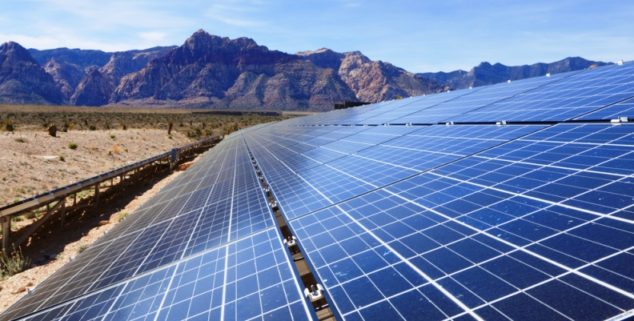News
Where water and electricity meet: Solar panels over canals
 An array of solar panels capture sunlight in the Mojave Desert of southern California. (Photo: Andrei Orlov, via Shutterstock)
An array of solar panels capture sunlight in the Mojave Desert of southern California. (Photo: Andrei Orlov, via Shutterstock)With record heat waves and stubborn droughts, the state needs electricity. A partial solution? California’s first project to cover a major canal with solar panels.
The Turlock Irrigation District (TID), the state Department of Water Resources, the water and energy project developer Solar AquaGrid, Marin County and UC Merced have partnered up on the project.
The goal is to provide clean power and avoid fossil fuels. Dubbed Project Nexus, they hope to build a large comprehensive system to help with both California’s energy and water needs.
If solar panels were installed on all 4,000 miles of California waterways, an estimated 63 billion gallons of water could be saved each year.
The Turlock district believes that the $20 million plan, which includes the installation of solar panel canopies over various sections of TID’s irrigation canal, will spark further development of solar-over-canal design elsewhere — including the massive, 444-mile-long California aqueduct.
“If this is something that works on these first two miles of Project Nexus that we’re doing, there’s the potential that this could scale to multiple locations,” Josh Weimer, Turlock Water & Power’s external affairs manager, told Reuters in August.
With an estimated 8,500 feet of solar panels projected to cover 3 sections of the TID canals in Central California, the local demand for electricity can be eased while preventing water loss due to evaporation. The sections include a 500-foot segment in Hickman and a mile-long section in nearby Ceres.
The scientific study published in the journal Nature Sustainability reported that if solar panels were installed across the state over all 4,000 miles of California waterways, an estimated 63 billion gallons of water could be saved each year. That would yield an estimated 13 gigawatts of renewable energy. A single gigawatt is enough electricity to power an estimated amount of 750,000 homes.
Project Nexus looked to India as an example, which began implementing solar panels above canals in 2011. By 2020, eight Indian states commissioned canal solar panel projects.
The solar panels can also help reduce weed and algae growth within the canals by reducing sun exposure, a long term issue with canals.
Sabah Usmani, an analyst at Environmental Defense Fund, suggested expanding solar farms above with hydropower from below if the Indian projects continue to be successful.
Amidst an interminable drought, this appears almost too good to be true.
Solar panels tend to struggle and lose efficiency during high temperatures, but placing them over canals actually helps keep the solar panels remain cool and more efficient.
The solar panels can also help reduce weed and algae growth within the canals by reducing sun exposure, a long term issue with canals.
There are drawbacks: Solar panels tend to be expensive and the material for storing electricity, typically batteries, are currently in high demand and that can bring up the price even more.
Monocrystalline solar panels, the most energy efficient model, currently costs $1-$1.50 per watt, or about $20 million for budget of the pilot Project Nexus project.
In California, peak electricity demand hit 52,061 megawatts during early September, the highest level since 2006.
However, solar panels have longevity: They are made to last more than 25 years with proper upkeep, with many solar panels installed as early as the 1980’s still working today at expected capacity.
California has also dealt with blackouts due to electricity demand.
DWR Director Karla Nemeth noted that “rolling blackouts highlighted the close connection between California’s energy and water systems.”
In California, peak electricity demand hit 52,061 megawatts during early September, the highest level since 2006. The power grid held — widespread blackouts were avoided, although some local outages were reported that apparently had no connection with the heat wave.
But the problem is likely to worsen amid heat- and drought-related failures.
As of July 2021, there are about 13.1 million homes in California, in which the solar panels covering the entire California system of aqueducts could produce enough electricity to power 9.75 million of those homes.
The project would help California meet its renewable energy goal of achieving 50% clean energy generation by 2025 and 60% by 203o.
While Project Nexus starts at a much less comprehensive distance of 8,500 feet to start, this project has huge expansion potential.
One of Project Nexus’ partners, Solar AquaGrid, was created by founding company Citizen Group, a Berkeley based marketing firm which not only participated with Project Nexus, but also looking to develop pilot projects with smaller water agencies that operate on canals.
As advancements in solar power continue to grow, Californians look closer to their goal of becoming a leader for clean energy and to be the first state to be completely free from dependency on fossil fuels.
—
Editor’s Note: Natalie Gess is a Capitol Weekly intern from UC Santa Barbara.
Want to see more stories like this? Sign up for The Roundup, the free daily newsletter about California politics from the editors of Capitol Weekly. Stay up to date on the news you need to know.
Sign up below, then look for a confirmation email in your inbox.

Leave a Reply